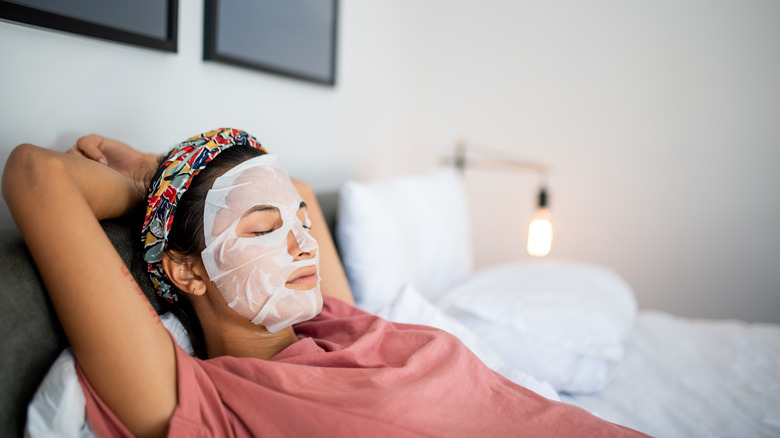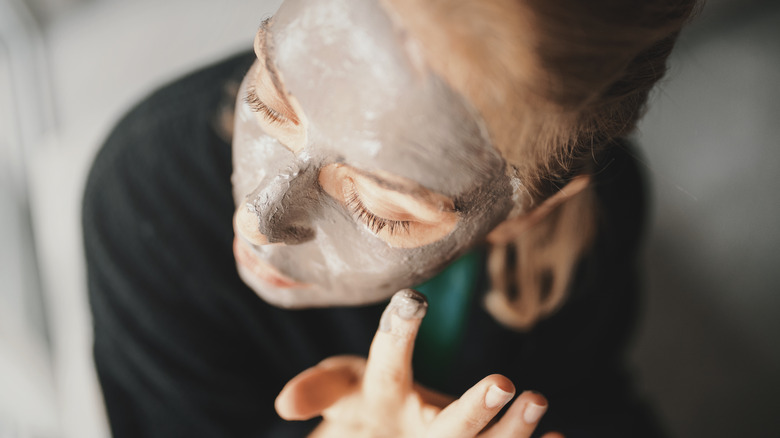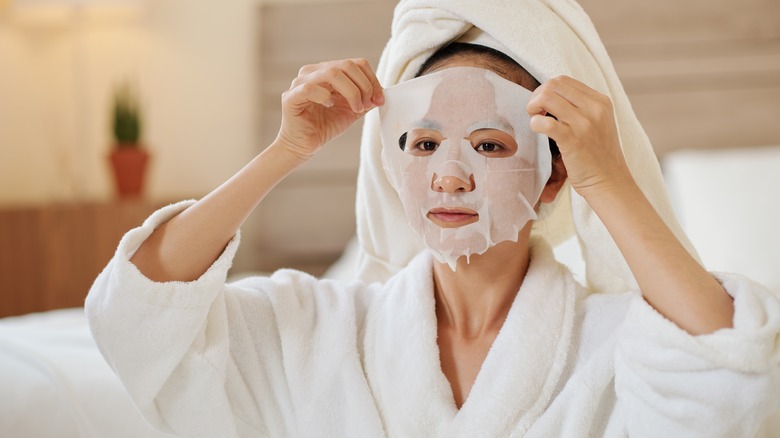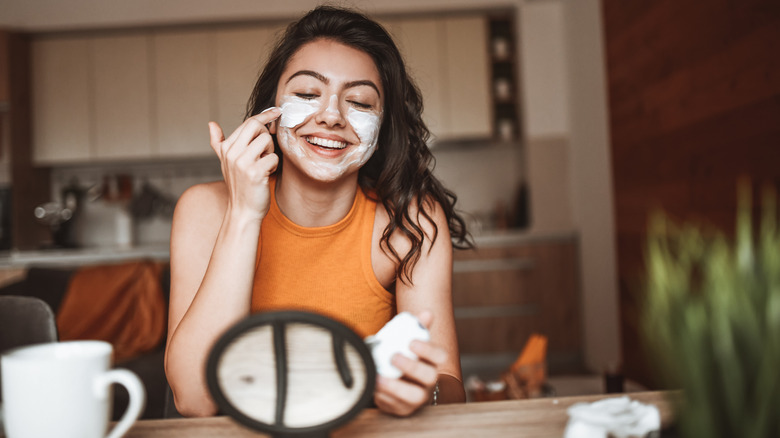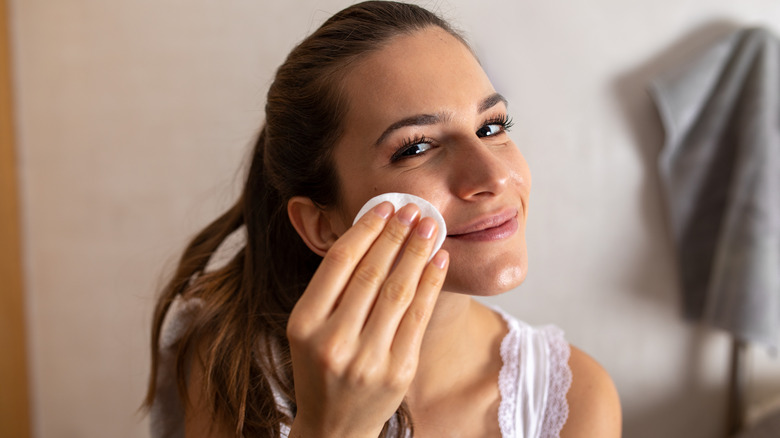Peel-Off Face Mask Mistakes That Can Spell Disaster For Your Skin
Face masks seem like the ultimate form of self-care. After all, the act of applying them is therapeutic in itself, and, best of all, they can yield great benefits for your skin. A staple at both spas and sleepovers, it's no wonder many people choose to make masks a part of their skincare routine.
A particularly popular form of masking is the peel-off variety. The immense success of peel-off face masks could lead you to reasonably assume they are universally beloved and effective. And while they can be, face masks, like every aspect of your skincare routine, should be carefully chosen for your skin's needs and type. Otherwise, making mistakes, like choosing the wrong type of mask or jumping into a peel-off session without the proper research and care, could do more harm than good. We're outlining every peel-off mistake you'll want to avoid for the sake of your skin.
Not knowing the risks
People love peel-off masks for more than just their aesthetic and propensity to trend well on TikTok. After all, the peeling process helps remove dead skin, reduce fine facial hairs, and unclog stubborn pores, as per CNN-News18. Beyond that, the hydrating component of the masks is sure to leave you feeling fresh and glowy.
However, part of what makes these masks so effective is their active ingredients. These powerful cleansers, exfoliators, and treatments require careful application, especially when working with space as sensitive and essential as your skin.
One big mistake is not being aware of the risks that come with removing face masks, particularly the peel-off variety. In fact, a woman went viral after she ripped a significant portion of her eyebrows off, along with her charcoal mask (via Metro). Therefore, understanding the goal of these masks, to remove dead skin and undesirable aspects of your top skin layer, is crucial to safely applying and removing these products. You won't be able to fully enjoy the benefits if you have unknown risks looming over you.
Overindulging in masks
When it comes to face masks, it is possible to experience too much of a good thing. In conversation with Insider, esthetician Evie Reyna explained that the act of peeling a mask off can also change your face over time. "Repeatedly pulling your skin out and down as we do when removing this mask can cause a loss of elasticity, which can ultimately lead to sagging skin," she shared. While there's nothing wrong with skin changing over time or with aging, overindulging in peel-off masks may accelerate facial transformations that could be unwanted.
For this reason, as well as giving your skin a break from the exfoliating aspects of peel-off masks, most experts recommend using these products no more than once a week, according to Healthline. If you think your skin could benefit from more frequent application, consult with a dermatologist who could recommend gentler products or a more varied routine.
Those with sensitive skin should be especially careful because peel-off masks seek to remove parts of your top skin layer, and overuse can lead to irritation.
Not knowing what you want from your mask
There are many different forms of face masks, which can all provide different benefits to your skin. You may not know, however, that there are large differences in mask goals, even within the same application type. Peel-off masks can be used to address many diverse skin problems, depending on the type of product you pick out.
They can tackle everything from hyperpigmentation to dehydration. Therefore, knowing your skincare goals while shopping for a face mask can make it so get the most out of your experience. While you likely won't encounter large problems from using a product that addresses a problem you don't have, you'll see better results from thought-through purchases.
You'll also want to avoid, for example, using a mask designed for oily skin on skin that's actually very dry. By understanding the mission of your mask, you'll also be able to better ensure that you're not overdoing it on one step of your skincare routine. No matter how stubborn your pores seem, you don't want to overwhelm them with too many blackhead-busting products in a row.
Skipping the instructions
Peel-off masks may seem self-explanatory. After all, most of the application steps are outlined in the name. Still, it's essential to take a close look at the instructions, ingredients, and warnings before diving in. The skin can be sensitive and unpredictable, and the last thing you want to do is cover your face with an unsuitable product.
If your product suggests testing the skincare solution on a small area of the skin before masking up, you'll want to take that recommendation. Although it could delay your spa day, this advice comes from a manufacturer that knows the strength and impact of certain ingredients. Even if you've never had an adverse reaction to a product or don't consider yourself to have sensitive skin, you'll be able to enjoy your mask more when you ensure that it agrees with your skin beforehand.
After all, the most common reaction to peel-off masks is contact dermatitis, as per Harley Street Emporium. This can present as redness and persistent itchiness. In the worst-case scenario, some users' skin may even peel.
Peeling it off too fast or too slow
Although face masks feel like an incredibly leisurely and casual activity, you should abide by the time constraints dictated on a face mask's packaging. In other words, you'll also want to be sure not to leave it on for too long. Trust us, leaving a face mask on for too long won't extend your relaxation.
No matter what type of peel-off you indulge in though, you need to know when to take it off. Hydrating masks, when left off too long, can become dry and begin absorbing your skin's essential moisture instead. "An exfoliating mask will often use actives, ... which can continue to get deeper and deeper as it sits on the skin, leading to a peeling response," dermatologist Dr. Dan Belkin explained to Real Simple. In a similar way, cleansing masks may finish removing dead skin and move on to stripping protective oil barriers from the skin.
And just like you want to be cautious of not moving too slow with how long you leave the mask on, when it's time to remove the face mask, take your time, as peeling it off too fast can understandably irritate.
Mixing different skincare products
Face masks inspire collaboration. Is there any better girls' night activity than applying a peel-off solution? While these treatments may work well in combination with your besties, they may not play nice with the rest of your skincare routine. If a peel-off mask is step ten in your skincare regimen, it may not be the finishing touch you've been seeking.
"Combining face masks with other [skincare] products that you regularly use, like retinoid creams, may increase your risk of adverse reactions," certified dermatologist Brundha Balaraman told Insider. Balaraman notes that every mask has a different intention based on its ingredients. If you have other products that are aiming to achieve a similar goal, consider swapping them out for a face mask, as opposed to doubling up on that product.
Beyond avoiding conflict within your routine, you should also be careful not to mix too many different face masks in quick succession. Unfortunately, switching up the type of face mask you use is not a loophole for getting out of using a face mask once a week, as we mentioned earlier. In conversation with Stylist, skincare co-founder Noella Gabriel explained that you should only double up on masks "if they are being used to target different areas or skin needs."
Not prepping your skin beforehand
Doing a face mask is a great way to engage in a facial reset. However, that doesn't get you out of prepping your face beforehand. To get the most out of your favorite peel-off, complete your typical cleansing routine prior to application. This freshens the surface and allows your skin to completely absorb the nutrients from your mask, according to Healthline. Without any sort of prep, the skin isn't getting ready to take in all the ingredients from the mask.
As mentioned before, take a close look at your skincare products, even if they are being used to prep your skin, and understand what ingredients are already at play. For those with sensitive skin, mixing a peel-off mask with solutions that already contain many actives could be overwhelming. Be on the lookout for ingredients like glycolic acid, retinol, and benzoyl peroxide, shares Essential Wholesale & Labs.
When in doubt regarding any skincare product, talk to your doctor or dermatologist and start small. Apply the mask to a small portion of the skin, and monitor for any adverse reactions before moving forward.
